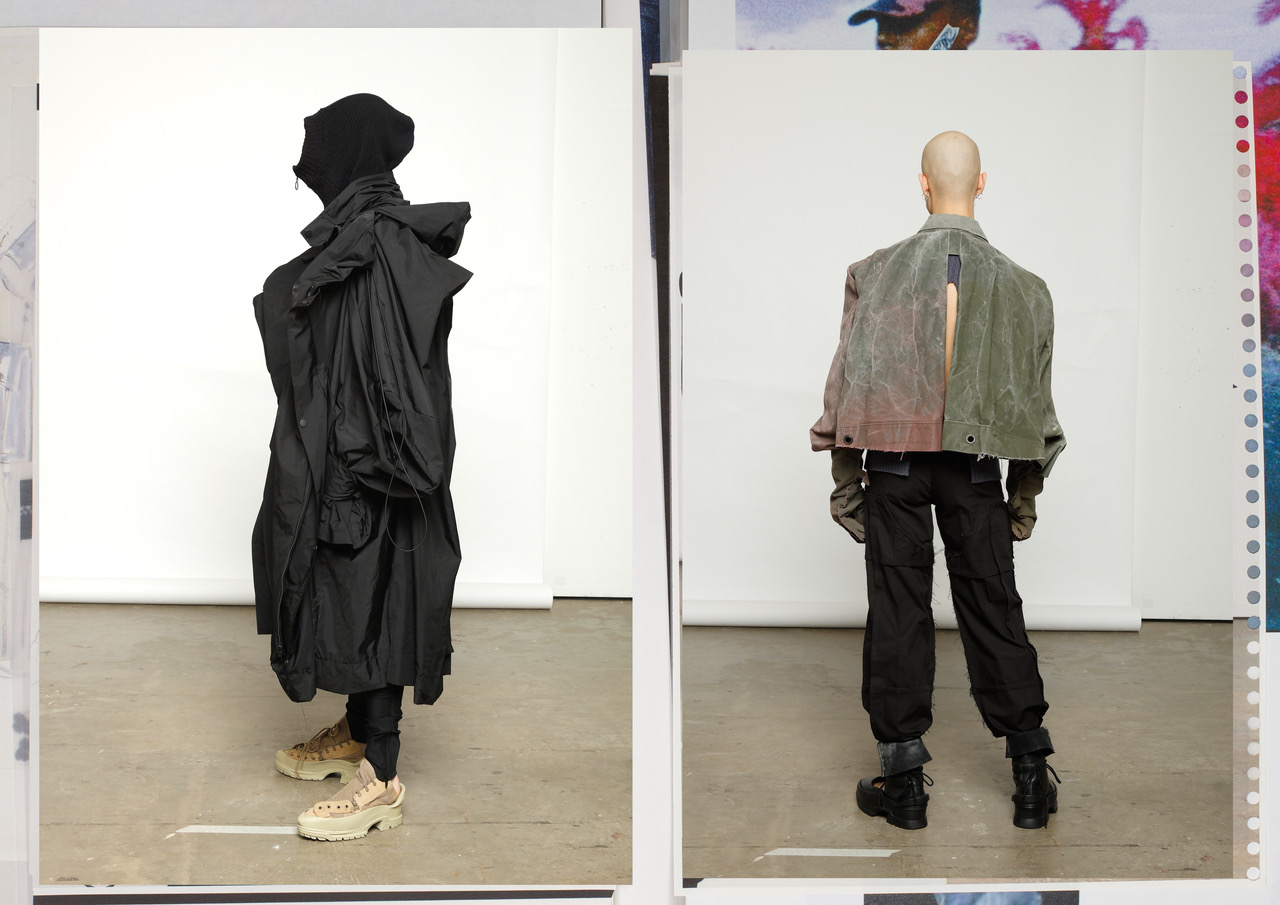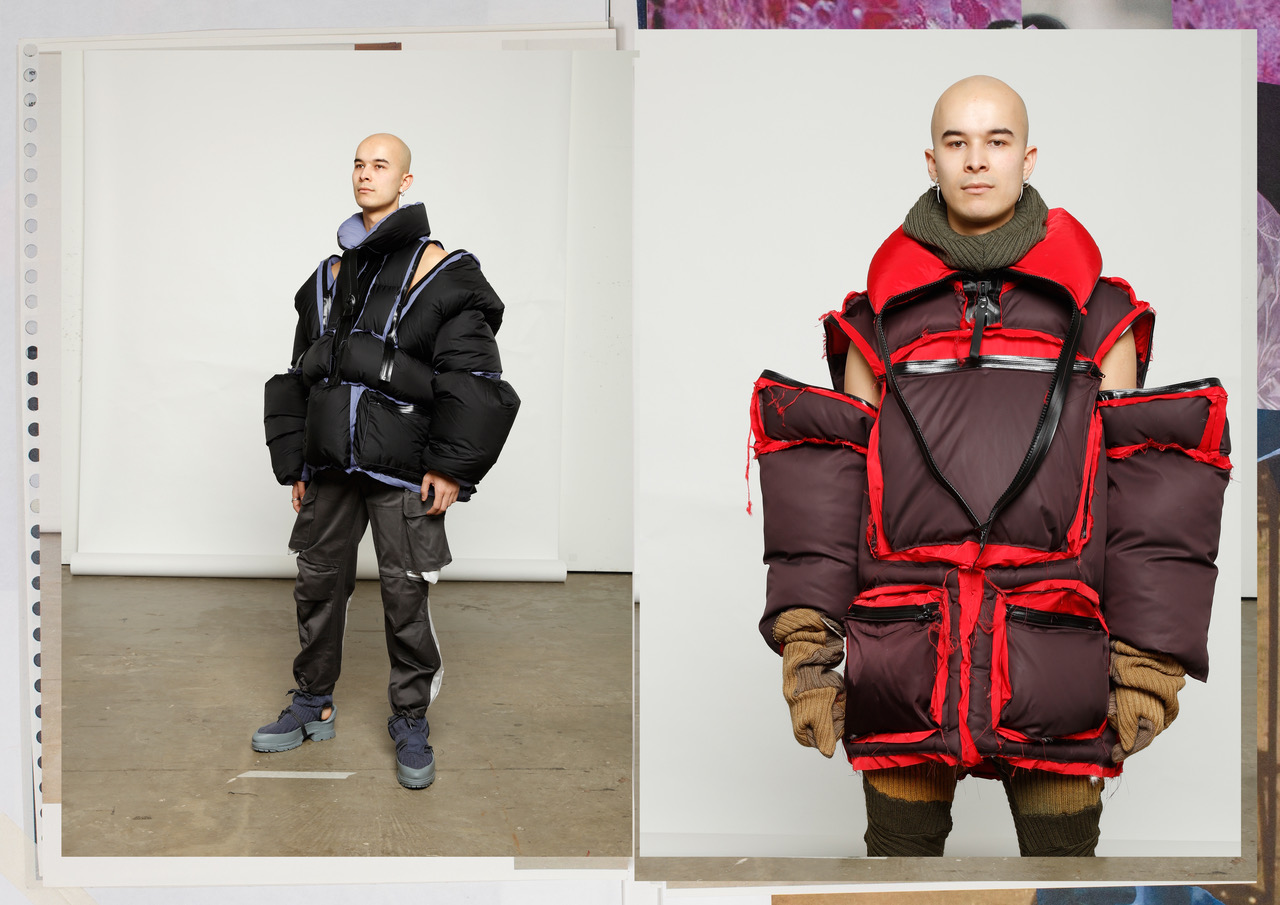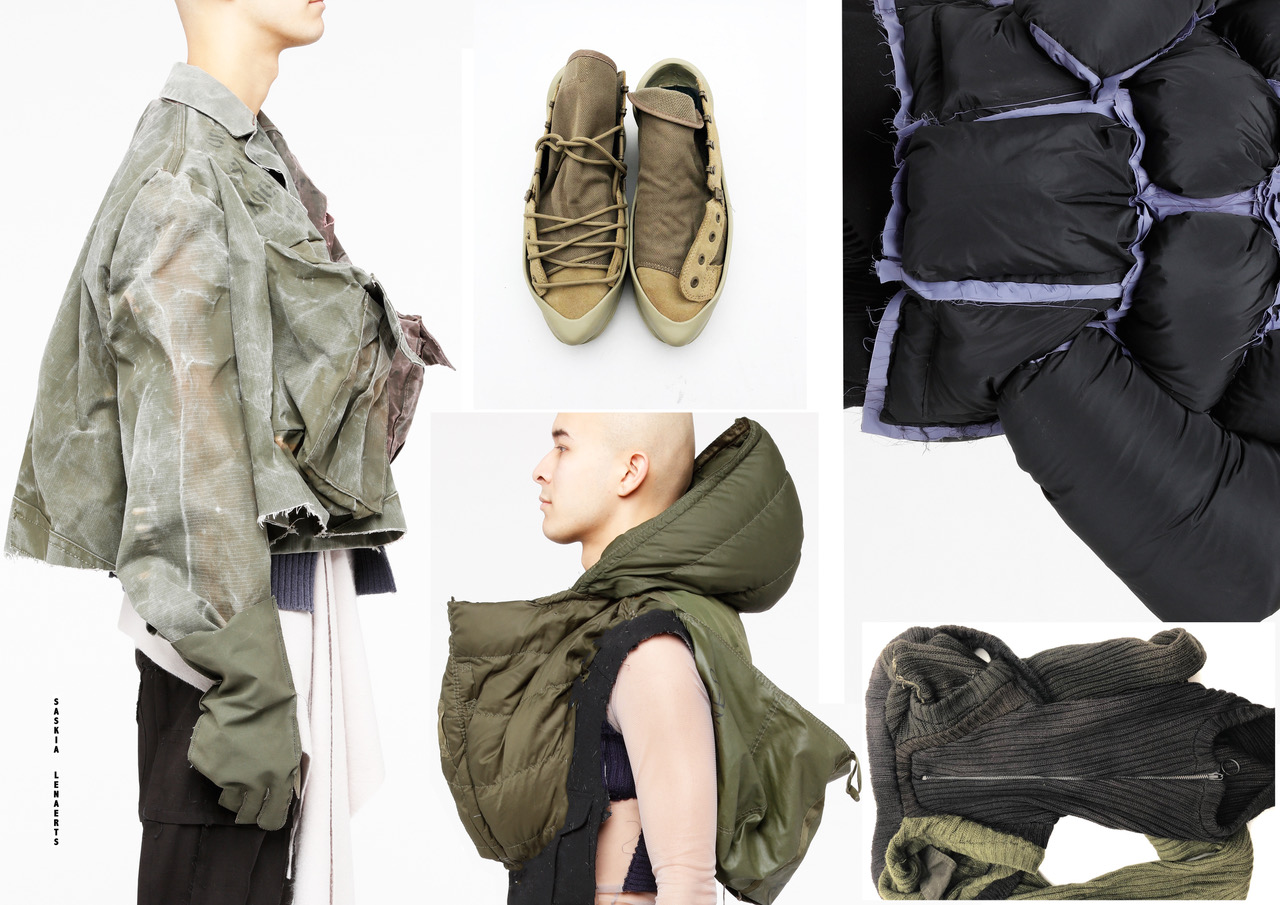Dis-Armed

Useful information
- Team members
- Saskia Lenaerts
- Country
- Belgium
- Keywords
- Transnational disarmed decommission military surplus upcycle repurpose recycle deadstock fashiondesign sustainable localised valuable design socio/political handmade non-violent anti-war borderless critical design considered design
Short Description
Trans-national design. Disarming military surplus for world peace.
Detailed Description
To decommission military garments is the target and an allegory for all the
borders I want demilitarised. This dis-armed collection is made up of up-cycled
military garments and deadstock fabrics. This presented me with an alternative
approach to the design and making process: the destruction, the unravelling, the
cutting open, the slashing and the extending/inverting of volume are key to the
design aesthetics. The silhouettes developed from various interpretations of “the
space (negative) between two opponents in combat”. Filling this negative space
creates a positive one. This represents to fill gaps and is a metaphor for closing
the socio/political and cultural gaps between people; as well as turning the
existing military garments into outright unmilitary ones, both in meaning and in
function. The outcome is subverting the viewer by referencing military garments
for an opposite and new purpose and eliminating their negative connotations
to portray my views on a borderless world.
Project Details
- Does your design take social and cultural challenges and human wellbeing into consideration?
An intrinsic part of my identity developed thanks to my diverse heritage, one
that has involved migration and cultural fuses throughout generations.
The cross-cultural and trans-national way of life is normal for me, and one that I
envision for the world.
For this collection, I invested in researching various relevant topics including
borders, belonging, displacement, home, cosmopolitanism, migration, etc., and
their meaning to me at this point in time.
Fuelled by the research I conducted for this collection and my personal
experiences, I set out to demilitarise military garments as an allegory for all the
borders, institutions and people I wish to see demilitarised.To bring this concept into effect I carefully selected and archived old
military/police uniforms (fighter pilot jumpers, combat boots, military truck
covers, ww2 infantry trousers, American ribstop cargo trousers, flight suits, wool
police jackets, artic duck down army sleeping bags) and dis-armed them.
I used various interpretations of the “negative space” to turn existing military
garments into outright unmilitary ones, both in meaning and function. And I
played with the positive space that is created by filling the negative one. This
technique represents a means to fill gaps and is a metaphor for closing the socio,
political and cultural gaps between people.
For the silhouettes, I worked with extended and inverted volumes that are
created via cut, by filling the garments’ excess spaces with repurposed duck
down and by cutting away the negative space to create the positive one. In this
way, the army surplus can begin to unravel and simulate the demilitarisation
process, ultimately mimicking the withdrawal of troops and violence.Our world’s current state of affairs evidences that my work is more relevant and
needed than ever before. I want to disarm people. This deep-rooted longing
comes from my family history of migration.
My work adds value to the much-needed political change. This collection is a
creative and sustainable manifestation of the deep injustice I see in the world.
How can we nurture and sustain our planet when we don’t see value in accepting
each other as human beings for our similarities and our differences?
I disarm and decommission military surplus for world peace.
I wish protesters on the streets today could wear my clothes to feel mightier and
more defiant towards injustice. Wearing what your oppressors wear is a
semiotic of equality.
- Does your design support sustainable production, embodying circular or regenerative design practices?
For the materials, as stated above, I repurposed and up-cycled old military
surplus. To balance the collection, the surplus is accompanied by adding in dead
stock nylons and wools sponsored by a Scottish mill “Johnstons of Elgin”. The
lions share of the collection is hand made by myself and for certain pieces I
worked together with local machinists in my studio in London. My collaboration
with them provided me additional insight to enhance the final production.
All pieces in this project can be reproduced locally. Taking into account that
using military surplus implies that all existing pieces might be a little different.
This adds to the character of the design and makes them to an extent all unique.
The disarmed garments add value to our world, because they change the
connotation of the military into something positive.
This entire collection can be produced and distributed locally, each country has
surplus of their own army stock and can be produced by local seamstresses,machinists and hence provide local employability. It can go from local
production and sourcing to localised consumption.
My garments have a pre-existing identity, to which, with my concept and
creativity, I add another layer so that subsequently those wearing them have the
chance to put their spin on it. And so the cycle is endless. This layered
enrichment is invaluable and symbolises for me ultimate luxury.
Repurposing gives new life to all things and shows respect to the artisans who
invested their time and skills into creating the beauty we surround ourselves
with. Each artisan adds character and life to a garment that a newly constructed
piece can never give us. Just like wine, which ages better with time.
Working with old garments and dead stock means taking history with us into the
future. It implies changing the conversation and physically alters their
significance and purpose.
I believe that this way of creating product is more impactful. Wearing old and
redefined military or police garments makes us defiant against war and brutality
whilst giving us the opportunity to take ownership of a part of history.
Sustainability must intertwine an outlook on life with materiality.
My work merges cultural/political sustainability with repurposing and up
cycling.
- Does your design promote awareness of responsible design and consumption?
To achieve a responsible world we must approach it holistically. I don’t believe
there is one way that works for all. Personally I found that repurposing garments
and using dead stock fabrics that go hand in hand with my concept is my way of
working and contributing.
As a designer who graduated at the end of March, the covid-19 crisis and
lockdown have been a blessing in disguise.
This crisis will impact our world and how we behave. In this context, I believe it
is an unprecedented opportunity for me with my work to find a new way into a
reinvented market. Present novel concepts and designs in this turbulent time
and challenge the existing status quo of the mass-produced, capitalist, throw
away, dispersed production and non-genuine culture we are drowning in.
This time confirms that there is room to have a small-scale brand. I see my
personal future as being a designer who works more like an artist; have projects,
collaborations, make unique pieces, be impactful by producing less.
Certain pieces of this collection are already available online and will be part of
new post-covid online platforms.
Fashion design implies a direct connection to aesthetics and the purpose of
wearing something is to empower you to represent yourself in a physical way,based on personality and aesthetic choices. The finishings and materials in this
collection combine function with aesthetics. They are made for human body with
comfort and ease being integral parts to the design.
My work asks the consumer to think about their choices, they can stand for
something by wearing my garments. Where do we buy, where did it come from,
where was it produced, what material is it, where did that material come from
and so on? It seems covid-19 has indirectly forced the consumer to finally think
that way and I hope it continues. We need to give garments the same respect and
longevity as we give to our jewellery, houses and furniture.
This project supports a local production and consumption by using what already
exists. I hope the value of this can finally be seen and adopted by the masses, to
buy what we truly love and value, respect everyone along our supply chain,
resist excessive continuous growth, but, most of all, I wish we can all move
slower together.
The opportunities that will come from winning the Distributed Design Award
will enhance my reach to empower people sustainably for generations to come.
The financial support will help me achieve my own project based trans-national
design studio and be able to locally craft my pieces with knowledgeable artisans
and produce small batches outside the seasonal fashion schedule.
This award will financially allow me to take time to conduct further indept
research into relevant topics concerning race, police history and brutality, which
are key to my practice and develop that research into new concepts and pieces.
Furthermore, I hope to make contact with larger production companies to be a
“designer in residence” at their factories, for a one to three month period to
develop up-cycled projects with their dead stock materials available on site. My
“designer in residence” concept will give me insight into the sustainable
struggles of the design industry whilst using my creative and repurposing values
and skills to help generate a greener future for them.
The award will provide me a broader platform to meet, collaborate and have
conversations with accomplished, talented and forward thinking creatives so we
can all learn how to merge "the maker" withe the "Digital age".
I believe winning the award will further accredit and certify my ambition to
disarm the world through durable fashion and help me become part of a new
generation of leading designers pushing for sustainability across the design
sector.
Images


